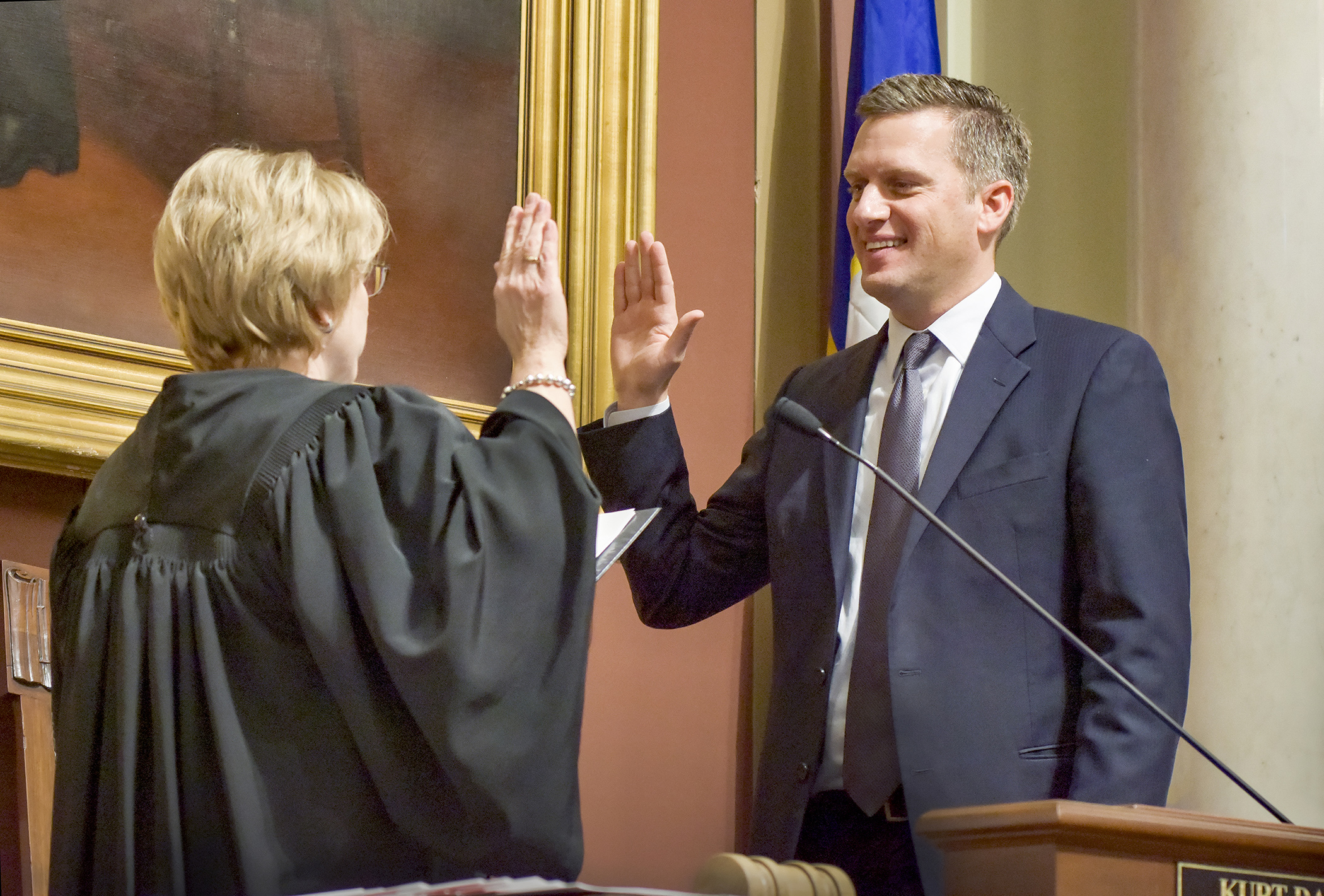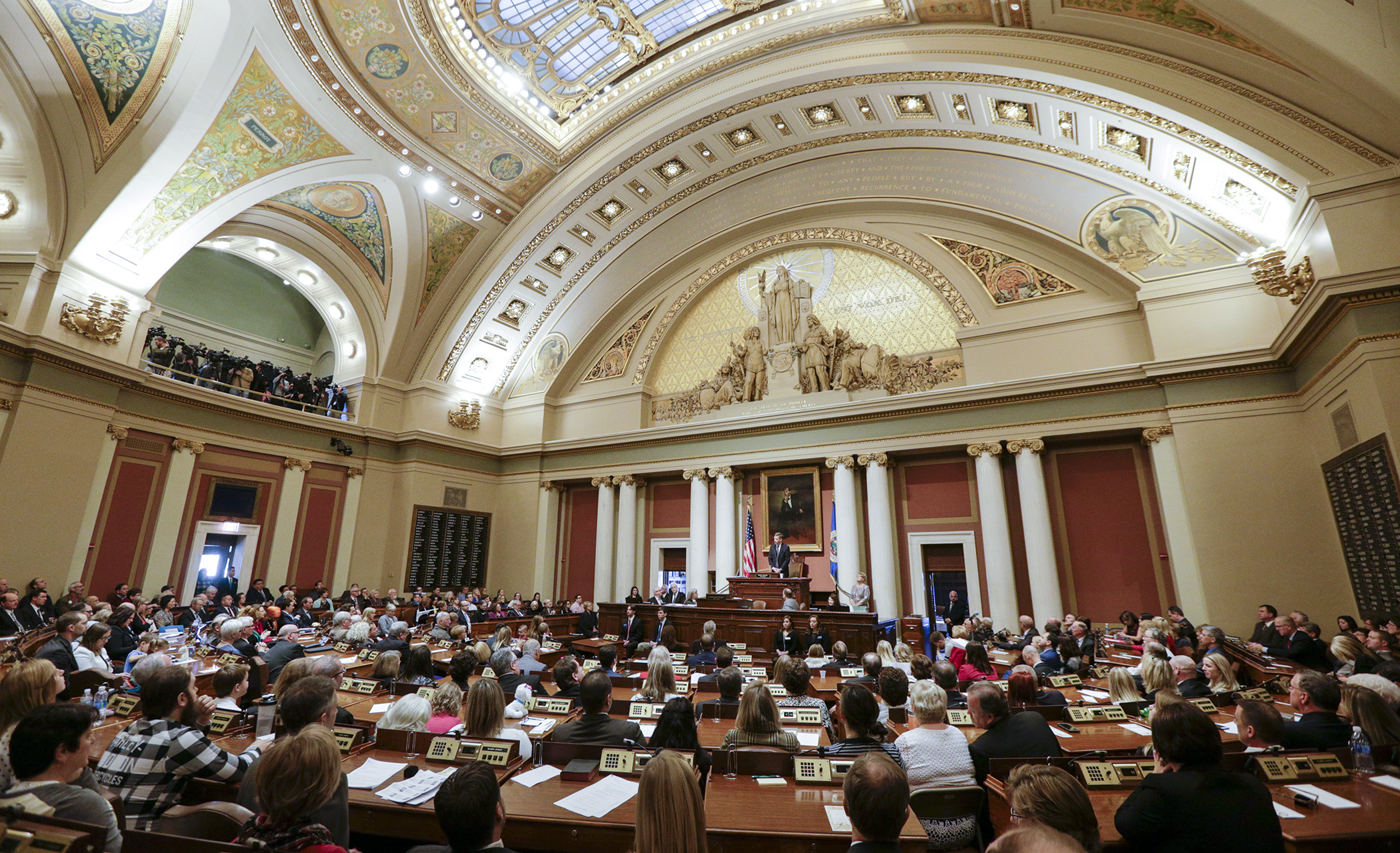Session opens with a number of unresolved issues

It was a day of selfies, swearings-in and standing ovations as the House opened the 2017-18 biennial session Tuesday.
The 90th Legislative Session began in St. Paul with lawmakers in a newly-renovated Chamber preparing to confront many unresolved issues that plagued their predecessors.
Republicans hold a 76-57 House majority, including 12 of 23 newly elected representatives. The 48 female House members is an all-time high. The District 32B seat is empty pending a Feb. 14 special election.
MORE 2017 session by the numbers
Legislative leaders pledged quick action to provide relief for rising health care insurance premiums and also vowed to tackle transportation funding, tax reform and other issues left unfinished at the close of last year’s session and not addressed in the interim.
However, Tuesday was more about pomp and procedure, with members making the first formal moves needed to start doing the House’s business.
Among them, House Speaker Kurt Daudt (R-Crown) was elected to his second term in charge by a 75-55 roll-call party-line vote.
All but one DFL member — Rep. Gene Pelowski (DFL-Winona) — cast their vote for House Minority Leader Melissa Hortman (DFL-Brooklyn Park). Two House members were absent.
In his opening remarks, Daudt pointed to the partisan divide in state government, with Mark Dayton, a DFLer, remaining in the governor’s office, and Republicans retaining control of the House and gaining a 34-33 Senate majority in the November election.
WATCH Highlights from the Minnesota House on opening day of the 2017 session
“Instead of single-party control, Minnesotans opted for balance, common sense and, ultimately, compromise,” Daudt said.
“We stand ready to work with Governor Dayton, DFLers in the Senate and the Republican majorities in the House and Senate,” Hortman said in a statement.
Visitors, family members and well-wishers crowded the halls outside the chamber, the gallery and the House Floor. One man in the gallery flashed a double thumbs-up as the members said, “I do” in unison to take the oath of office.
Rep. Mike Freiberg (DFL-Golden Valley) paid tribute to Rep. Lyndon Carlson Sr. (DFL-Crystal), who on Tuesday became the longest-serving House member in state history. Carlson, he said, has not missed a single day over his record span of 16,073 days of legislative service.
An odd-numbered year, such as 2017, is traditionally focused on setting the state’s two-year budget that begins July 1. Without an agreement, a state government shutdown would occur.
Lawmakers must complete their work by May 22.
But the budget is not all members are expected to address in the next five months. Here’s a look at some of the other issues:
Health care cost relief
 House Speaker Kurt Daudt addresses House members after he is sworn in during the opening day of the 2017-18 legislative session Jan. 3. This is Daudt’s second biennium leading the body. Photo by Paul Battaglia
House Speaker Kurt Daudt addresses House members after he is sworn in during the opening day of the 2017-18 legislative session Jan. 3. This is Daudt’s second biennium leading the body. Photo by Paul Battaglia When talk turned to the issues facing this year’s session, the top priority in everyone’s mind seems to be a solution that will address rising health care insurance premiums.
Daudt said legislation to provide financial relief is the top priority of his caucus, although long-term reform is also needed.
“Our hope is to have the short-term bill moving next week and off of the House Floor,” Daudt said. “Of course we have to work with the Republican Senate and a Democrat governor, so we have to be flexible and making sure that we’re adapting to get the best product for Minnesota.”
Hortman said it was possible the legislation could move quickly, but she first wanted to see what Republicans propose.
“I’m guardedly optimistic until I see the words written down on the piece of paper,” she said. “That’s always the tricky part.”
Despite ongoing talks over the last few months, a special session to address the problem failed to materialize. Talks between Dayton and legislative leaders broke off Dec. 16. And Daudt said then the House would pass a health care premium relief bill the first week of session.
Dayton provided legislators a starting point Tuesday, proposing a plan that would provide a 25 percent rebate for Minnesotans who purchase their own insurance, but earn too much to qualify for federal tax credits: those with individual incomes of over $47,520 and families of four with incomes over $97,200. The governor wants action this week.
LISTEN Gov. Dayton's news conference
Helping offset soaring health care premiums — some more than 50 percent — for approximately 125,000 Minnesotans was cited by both Republicans and DFLers as a primary reason for a special session late in 2016.
For immediate relief, Dayton proposed a 25 percent health care rebate in October that would have cost the state an estimated $313 million. Three weeks earlier, House Republicans offered their own plan to lower costs and expand health care choices.
However, changes to — or repeal of — the federal Affordable Care Act could force Minnesota to alter any short-term fix.
Daudt said he would try to meet with the governor Tuesday afternoon to learn more about his preferences on the issue.
“We need to have the governor’s input,” Daudt said. “We want a bill that’s going to get signed by the governor.”
Taxes
Last session’s tax bill, with its proposed $257 million in tax relief last year and $543 million in the 2017-18 biennium, received strong bipartisan support. However, due to a one-word drafting error, it was vetoed by Dayton. It, too, was action-fodder for a special session.
With a potential $1.4 billion budget surplus, lawmakers are expected to revive last session’s bill, and craft a new proposal that could include:
- a student loan tax credit;
- expansion of the child care tax credit;
- tax deductions and credits for families contributing to 529 savings plans;
- expansion of the working family tax credit;
- expansion of tax credits for some veterans;
- a school building bond agricultural credit; and
- phase-out of the state general levy (applies to commercial and seasonal properties).
Transportation tie-up
While the need for road and bridge repair throughout the state continues to grow, funding continues to hit road blocks. According to Transportation Department officials, the state faces an estimated $16 billion need over the next two decades.
Expanded transit, particularly in the Twin Cities metropolitan area, remains a priority for some lawmakers.
WATCH Election of the House Speaker on opening day of the 2017 session
Transportation funding appeared to get little play during interim special session discussions.
The Republican-backed plan passed last spring in the House would have raised an additional $7 billion for roads and bridges over the next decade in part by redirecting motor vehicle-related tax revenue away from the state’s General Fund, identifying efficiencies in the MnDOT budget, and utilizing some of the state’s budget surplus.
In contrast, the DFL-backed Senate bill proposed to raise roughly $11 billion for roads and bridges, as well as transit — something neglected in the House bill — by instituting a new gas tax and expanding a metro area transit-dedicated sales tax from one-quarter to three-quarters of a cent.
Capital investment conundrum
House and Senate lawmakers failed to pass a roughly $1 billion borrowing package for public works projects across the state — traditionally the centerpiece of even-year legislative years — in the chaotic final minutes of the 2016 session.
People and organizations wanting funds in 2017 probably shouldn’t hold their breath.
Once special session hopes died in mid-December, Daudt indicated there may not be a bonding bill this year. However, Dayton is scheduled to unveil a capital investment package Wednesday.
Senate Minority Leader Tom Bakk (DFL-Cook) said Dec. 16 that he doesn’t anticipate passage of a $1 billion bonding bill in 2017, a traditional budget-setting year for the Legislature, nor does he see support for a $2 billion package in 2018.
“What this means to me is all these projects are going to wait until 2018 before they get considered. Construction and inflation are going to require all them to be more expensive. … If the bonding bill waits until ’18, we get a billion dollars behind,” he said then.
Writers Jon Mohr, Chris Steller and Mike Cook contributed to this story
Related Articles
Search Session Daily
Advanced Search OptionsPriority Dailies
Ways and Means Committee OKs proposed $512 million supplemental budget on party-line vote
By Mike Cook Meeting more needs or fiscal irresponsibility is one way to sum up the differences among the two parties on a supplemental spending package a year after a $72 billion state budg...
Meeting more needs or fiscal irresponsibility is one way to sum up the differences among the two parties on a supplemental spending package a year after a $72 billion state budg...
Minnesota’s projected budget surplus balloons to $3.7 billion, but fiscal pressure still looms
By Rob Hubbard Just as Minnesota has experienced a warmer winter than usual, so has the state’s budget outlook warmed over the past few months.
On Thursday, Minnesota Management and Budget...
Just as Minnesota has experienced a warmer winter than usual, so has the state’s budget outlook warmed over the past few months.
On Thursday, Minnesota Management and Budget...